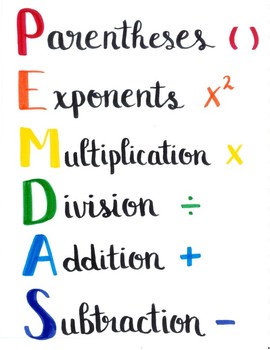5.5 KiB
Unit 1: Essential Skills
Simple Arithmetics
Addition / Subtraction
| Expression | Equivalent |
|---|---|
| \(`a + b`\) | \(`a + b`\) |
| \(`(-a) + b`\) | \(`b - a`\) |
| \(`a + (-b)`\) | \(`a - b`\) |
| \(`(-a) + (-b)`\) | \(`-(a + b)`\) |
| \(`a - b`\) | \(`a - b`\) |
| \(`a - (-b)`\) | \(`a + b`\) |
| \(`(-a) -(-b)`\) | \(`(-a) + b`\) |
Multiplication / Division
| Signs | Outcome |
|---|---|
| \(`a \times b`\) | Positive |
| \(`(-a) \times b`\) | Negative |
| \(`a \times (-b)`\) | Negative |
| \(`(-a) \times (-b)`\) | Positive |
BEDMAS / PEMDAS
- Follow
BEDMASfor order of operations if there are more than one operation
| Letter | Meaning |
|---|---|
| B / P | Bracket / Parentheses |
| E | Exponent |
| D | Divison |
| M | Multiplication |
| A | Addition |
| S | Subtraction |
Interval Notation
A notation that represents an interval as a pair of numbers.
The numbers in the interval represent the endpoint. E.g. \(`[x > 3, x \isin R]`\)
|meanssuch that
Eor ∈ meanselement of
Nrepresents Natural Numbers \(`N = \{x | x \gt 0, x \isin \mathbb{Z} \}`\)
Wrepresents Whole Numbers \(`W = \{x | x \ge 0, x \isin \mathbb{Z}\}`\)Zrepresents Integers \(`Z = \{x| -\infin \le x \le \infin, x \isin \mathbb{Z}\}`\)Qrepresents Rational Numbers \(`Q = \{ \frac{a}{b} |a, b \isin \mathbb{Z}, b \neq 0 \}`\)Symbol Meaning \(`(a, b)`\) Between but not including \(`a`\) or \(`b`\), you also use this for \(`\infty`\) \(`[a, b]`\) Inclusive \(`a ∪ b`\) Union (or) \(`a ∩ b`\) Intersection (and)
Pythgorean Theorem
a and b are the two legs of the triangle or two sides that form a 90 degree angle of the triangle, c is the hypotenuse
\(`a^2+b^2=c^2`\)

Operations with Rationals
\(`Q = \{ \frac{a}{b} |a, b \isin \mathbb{Z}, b \neq 0 \}`\)
Any operations with rationals, there are 2 sets of rules
Rules for operations with integersRules for operations with fractions
To Add / subtract rationals, find common denominator and then add / subtract numerator
To Multiply rationals, first reduce the fraction to their lowest terms, then multiply numerators and denominators
To Divide rationals, multiply them by the reciprocal
Example Simplify Fully:
\(` \dfrac{3}{4} \div \dfrac{2}{14} `\) Reduce to lowest terms
\(` \dfrac{3}{4} \div \dfrac{1}{7} `\) Multiple by reciprocal
\(` \dfrac{3}{4} \times 7 `\)
\(` = \dfrac{21}{4}`\) Leave as improper fraction
Shortcut for multiplying fractions
cross divide to keep your numbers small
Example:
\(` \dfrac{3}{4} \times \dfrac{2}{12} `\)
\(` \dfrac{1}{2} \times \dfrac{1}{4} `\)
\(` = \dfrac{1}{8} `\)
Exponent Laws
| Rule | Description | Example |
|---|---|---|
| Product | \(`a^m \times a^n = a^{n+m}`\) | \(`2^3 \times 2^2 = 2^5`\) |
| Quotient | \(`a^m \div a^n = a^{n-m}`\) | \(`3^4 \div 3^2 = 3^2`\) |
| Power of a Power | \(`(a^m)^n = a^mn`\) | \(`(2^3)^2 = 2^6`\) |
| Power of a Quotient | \(`(\dfrac{a}{b})^n = \dfrac{a^n}{b^n}`\) | \(`(\dfrac{2}{3})^4 = \dfrac{2^4}{3^4}`\) |
| Zero as Exponents | \(`a^0 = 1`\) | \(`21^0 = 1`\) |
| Negative Exponents | \(`a^{-m} = \dfrac{1}{a^m}`\) | \(`1^{-10} = \dfrac{1}{1^{10}}`\) |
| Rational Exponents | \(`a^{\frac{n}{m}} = (\sqrt[m]{a})^n`\) | \(`16^{\frac{5}{4}} = (\sqrt[4]{16})^5`\) |
Note:
- Exponential Form –> Expanded Form
- 64 = 6 × 6 × 6 × 6
Scientific Notation
They convey accuracy and precision. It can either be written as its original number or in scientific notation:
555 (Exact) or \(`5.55 \times 10^2`\) (3 significant figures).
In scientific notation, values are written in the form \(`a(10^n)`\), where \(`a`\) is a number within 1 and 10 and \(`n`\) is any integer.
Some examples include the following: \(`5.4 \times 10^3, 3.0 \times 10^2`\), and \(`4.56 \times 10^{-4}`\).
When the number is smaller than 1, a negative exponent is used, when the number is bigger than 10, a positve exponent is used

Remember: For scientific notation, round to
3 significantdigits
Rates, Ratio and Percent
Ratio: A comparison of quantities with the same unit. These are to be reduced to lowest terms.
Examples:
a:b, a:b:c, a/b, a to bRates: A comparison of quantities expressed in different units.
Example:
10km/hourPercent: A fraction or ratio in which the denominator is 100
Examples:
50%, 240/100
Number Lines
- a line that goes from a point to another point, a way to visualize
set notations and the like

- A solid filled dot is used for
[]and a empty dot is used for()
Tips
- Watch out for the
+/-signs
- Make sure to review your knowledge of the exponent laws
- For scientific notation, watch out for the decimal point
- Use shortcut when multiplying fractions
